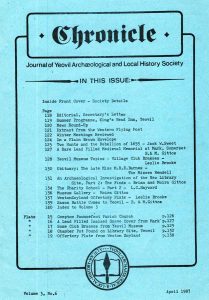1987-Apr-pg139_Saxon Battle Comes to Yeovil
This article came from Chronicle published April 1987. Page: 139.
Saxon Battle Comes to Yeovil
Authors: Brian and Moira Gittos
A one-day course entitled “The Origins of Yeovil” was held at Yeovil College on 28th February. It was divided into four lectures given in turn by the tutors, Mike Costen and Katherine Barker. The course was well attended and proved extremely rewarding. Katherine Barker described the twilight of the Roman era and what followed, in terms of the information which can be derived from studying boundaries. Ilchester’s importance during this period was stressed, with the southern limit of its territorium lying along Combe Street Lane and Thorne Lane. The 1904 O.S. map shows a Roman milestone, on this boundary, where Thorne Lane meets Larkhill. Another marker stone, found by the A303 near Ham Hill in the 1930’s is now in Taunton Museum. It commemorates Emperor Flavius Valerius Severus who ruled for a single year (305-306 AD). Yeovil lay outside Ilchester’s zone of influence, at the point where it is assumed an ancient trackway linking the forts of Ham Hill and South Cadbury crossed the River Yeovil (Giffle). Evidence of this comes from a 16th C. reference to Babylon Hill as “Buell Way”. Buell is Celtic and has a common origin with the Welsh name Builth. Mike Costen discussed the break up of the multiple estates in the Anglo-Saxon period. He used place name evidence to support his theories, with that of boundaries and field patterns. He explained how multiple estates were subdivided to generate revenue and used the example of the Chinnocks to develop this theme.
Katherine Barker examined the development of the borough at Yeovil and postulated a Roman township at Westland. She showed how the Yeovil valley could be divided into units of nine smaller manors, each about 1km square and roughly equivalent to 1 hide at Domesday. The royal manor of Kingston did not feature in the 1086 survey, but its hidage could be deduced from the boundary pattern. The importance of the Hundred division was outlined and illustrated with slides of the Hundred Stone. Katherine Barker then convincingly demonstrated that Yeovil was the site of an important battle marking the Anglo-Saxon conquest of the area. The Anglo-Saxon Chronicle records the great battle of Poenan ( which may be translated as ‘the Pens’), in 658 and the retreat of the defeated Britons to the river Parrett. ‘The Pens’, from the celtic word for hill, is usually interpreted as Penselwood but it can more correctly be taken to mean Yeovil’s group of small hills, Summerhouse Hill, Wyndham Hill and Penn Hill. (For a general discussion of the battle and its implications see Havinden, M. The Somerset Landscape,, 1981, in the “Making of the English Landscape” series) This would mean that Yeovil is the site of a major conflict far more significant than the Civil War skirmish on Babylon Hill. The day was completed by Mike Costen’s use of Domesday evidence to demonstrate the relative stability of south east Somerset in the 11th C. After lunch, the sole remnant of Saxon Yeovil was displayed – the 9th or 10th C. spur excavated on the Westland site in 1928, but only identified last year.
